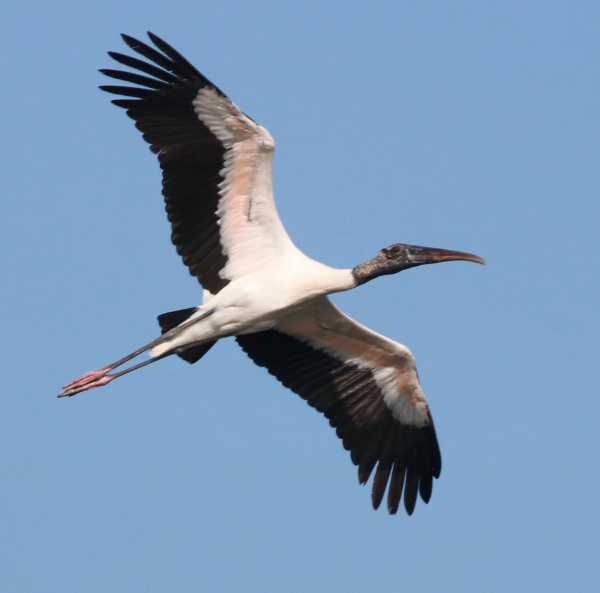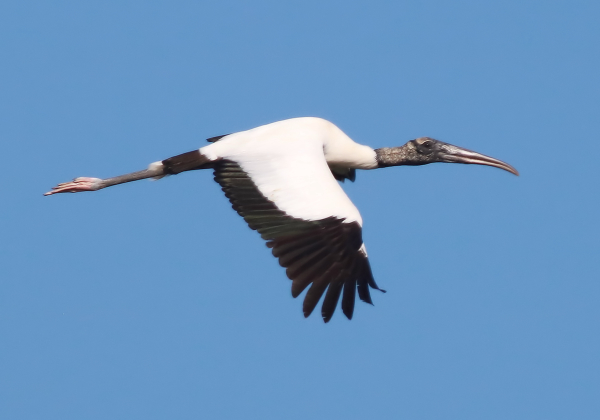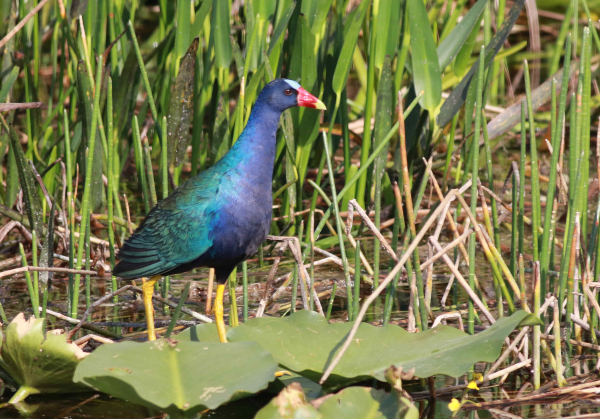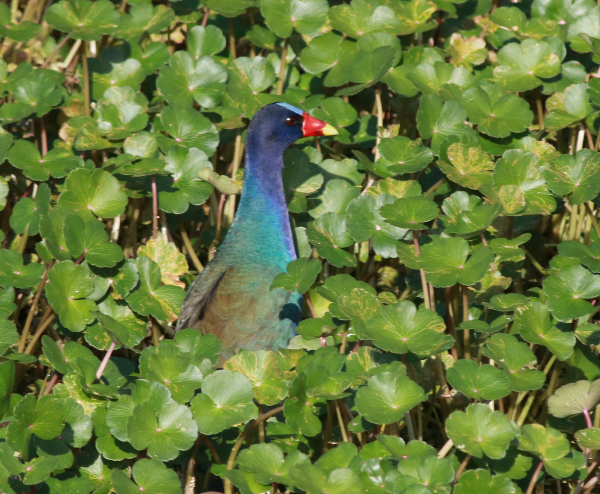Imagine a raptor, a velociraptor, with wings! That’s what I was seeing through my camera’s viewfinder when I took a moment to really think about it. Deep in the southern edge of the Everglades, velociraptor after velociraptor winged by on steady wingbeats facing into the already strong north wind. The big dinosaur-looking birds with broad wingspreads and massive beaks offered the kinds of flight photos I was hoping for that sunny morning along the edge of an alligator pond that separated me from the new activity at a wading bird rookery filled with Wood Storks and fewer numbers of Roseate Spoonbills and Great Egrets.
But I’m not kidding about the dinosaur looks of the monster-sized Wood Storks. If you were a frog, you’d be absolutely terrified to see one of these tall feathered monsters stalking your way through the shallow water on branch-sized legs with a bare scaly black neck and face that extends into a massive black beak pointed at you – yikes!

A classic image of a Wood Stork in flight with the morning light providing nice contrast, but as the bird banked to one side, it eliminated shadows present in other photos taken during the same period.
Other birds in the area included White Ibis, Anhingas, and Tricolored Herons, all taking their turns flying by, along with an occasional Osprey, Swallow-tailed Kite, Green Heron, Great Blue Heron, Snowy Egret, White Pelican, Double-crested Cormorant, and Red-shouldered Hawk. This is the kind of place that I like to look for when I’m photographing in the field; a “pass” where birds are flying back and forth along a fairly predictable route where I can position myself with my camera. That morning – last Friday – Good Friday, was quite a thrill as these big birds flew by every few minutes.
I was surprised that Saturday, under similar beautiful morning light with a lesser north wind, the birds were much less active and flights past that location were greatly reduced. Of course, the moral of that story is that nature is relatively unpredictable, and bird behavior changes quickly at times. We need to take advantage of photo situations when they avail themselves, and roll with other options when necessary. But back to Friday morning’s flights: It was great that my primary species of interest that day was Wood Storks, and they kept me excited with many birds flying toward my position, then breaking to the right, into the wind and often tipping into the early sunlight.
With the birds flying above me, I immediately realized how nice it was to photograph from the elevated walkway adjacent to the High Island rookery the week before. Now I had to get re-adjusted to photographing from below the birds, with the sun’s angle getting ever-higher in the sky. The birds were beautifully illuminated, but with their wings ever-moving I tried to keep shadow angles in mind when I elected to take individual photos. I usually took 1 or 2 photos at a time, but a couple of times, as a stork made an especially nice flight before me, I took a series of 10 or 12 photos to get a full assortment of images with the bird’s wings positioned up and down and in between. Then, I could select the best with respect to the flight position and the play of the shadows mostly beneath the bird, or behind it.

Although not very evident in these stork images, some photos showed the “black” wing and tail feathers actually have an iridescent green in the right light.
To take a series of photos, I merely held the shutter button on my camera down for a couple seconds, utilizing my usual continuous photo setting. As for the other settings, I never use an automatic setting, but set the Mode Dial to Av, which is an Aperture Priority setting that automatically provides the corresponding shutter speed. With ample sunlight I used my standard aperture setting of f-8, and the resulting shutter speeds varied from 1/1200 to 1/1600 of a second, providing very sharp flight photographs.
As usual, high-speed still photos provided me with a chance to see some features of Wood Stork plumage that included faint peach-colored feathers along the underside of the wing muscles. Also, primaries and especially the secondary wing feathers that usually look black were revealed to have an iridescent green shine when the sunlight hits them just right. This is also true for the “black” tail feathers. It’s a part of photography that I greatly appreciate after the action in the field – analyzing the finer points that are revealed in the resulting photos.

As with any bird photography, the right lighting is critical to show the iridescent colors of a Purple Gallinule amid equally vibrant green vegetation. Positioning yourself with the sun at your back and your shadow pointing at the bird is also paramount to using the sunlight at its best.
Speaking of iridescent colors, there was another chapter to my Friday Florida photography safari. By noon, with the sun directly overhead until later in the day, and with extremely high winds affecting the birds in the Everglades, I decided to interject another photo location into my afternoon planning. I decided to try to squeeze in a stop at Loxahatchee National Wildlife Refuge west of Boca Raton and about 2 hours north of the Homestead entrance to Everglades National Park. All that repositioning was part of my search for one of the world’s rainbow birds.
All the Colors of the Rainbow!
Gray clouds rolled in from the Atlantic Coast as I drove north, and it even sprinkled a couple times along the way, but I hoped for a sun-break in the clouds by the time I reached Loxahatchee. I chose a walking trail after an initial short drive to canvass the area, and by the time I hit the trail, the sun broke through and the wind was less of a factor in the recesses of the water lily-covered ponds I trekked by. With a few Glossy Ibis here and a Tricolored Heron there; a couple Common Gallinules and some American Coots worked their way through the shallows between the lily pad leaves and stems, and I watched for a Limpkin or Snail Kite, 2 of the 3 birds I was most interested in finding at the refuge.

A close-up of a Purple Gallinule feeding apart from its usual tangles of water lilies provides a sharp portrait of the tropical species.
Suddenly, there it was – a Purple Gallinule – its vibrant iridescent colors reflecting in the 4pm afternoon sunlight as it plied its way through the maze of lily leaves in search of large insects and small frogs, but especially water lily seed pods. I was relatively close, and the rainbow bird was aware of me but continued with its walk through the pads, using its splayed super-elongated toes to walk atop the broad lily leaves.
At first it was hard to get a clear photo of the gallinule as it weaved its way through the lilies, plodding along as each foothold slowly sank under the weight of the bird. If it kept moving, it was able to stay mostly above the water surface.
Now my photo subjects were in a completely different photo landscape than the morning birds in flight, and that might require different camera settings. There was no blue sky background, or even a monotone setting, but lots of vegetation – beautifully colored green emergent aquatic plants. I reduced the aperture slightly to f-7, which provided a shutter speed at 1/1250 to 1/1000 of a second – a little slower than the morning’s stork photos, but there was less action to stop than in the flight photos. The changes were small, but appear to be just right considering the rich colors of the birds and the plants.

It’s important to have a little fun with your photography too. Try moving the bird to one side or the other as you compose images. This can be done in the field, or even when cropping photos using photo editing software.
I eventually observed 8 Purple Gallinules along shallows bordering the hiking trail, some feeding among water lilies and other feeding among different plants. I tried to be creative as I composed some of the photos I took later, trying to show the bird immersed within its natural elements and trying to show some character in individuals as well.
So between the 2 primary species I photographed last Friday – the dinosaurs and the rainbow birds – it was quite a day, offering 2 different settings (sky and plants), and 2 different activities (flying and feeding) with dramatic eye-catching birds in both locations. Friday was a day I will long remember for the birds that entered my field of view. It’s important for us to plan ahead to visit a location where we can enjoy similar special bird photography outings as we enjoy our spring birding activities. April will be filled with exciting birds for us all, for there are flying dinosaurs and rainbow birds to be found across the land and seas.
Article and photographs by Paul Konrad
Share your bird photos and birding experiences at editorstbw2@gmail.com